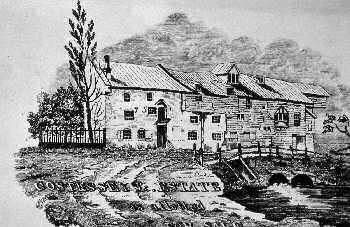 |
|
Engraving
from a 1750 estate sale catalogue
|
|
Costessey Mill
River Wensum |
 |
|
Engraving
from a 1750 estate sale catalogue
|
|
Costessey water
milll was another Domesday site and probably saw many structures over
the centuries. |
 |
Bury & Norwich Post - 22nd November 1786 |
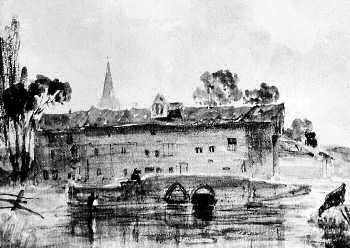 |
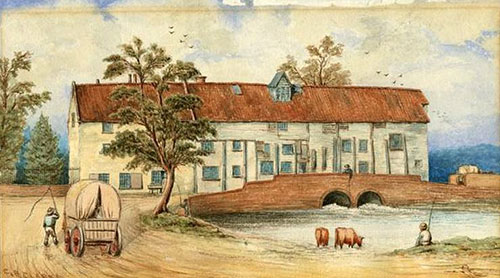 |
|
Drawing
from an 1816 sale catalogue
|
C. B. Clarke painting - 1858 |
|
NORFOLK QUARTER SESSIONS
before H. C. PARTRIDGE, Esq |
John Farman, aged 21, and Samuel Farman, aged 18, were
charged with having, on the 24th of September, at Costessey, stolen twenty-eight
pounds weight of hay, the property of John Culley, miller. The prisoners were observed in the act of taking the hay from Mr Culley's stack-yard by Inspector Barrett, who was on duty in the neighbourhood. - Guilty: 14 days' imprisonment with hard labour. Norwich Mercury - Saturday October 18th 1845 |
Henry
Utting Culley hired the millwrights Smithdales
to repair the steam engine during the first three months of 1859 at about
the time the new mill was being built. |
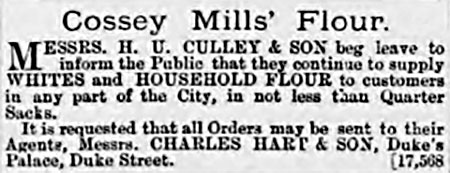 |
Norfolk News - 25th December 1869 |
1857: William John Pollard born at Stoke Ferry Census 1871: William John Pollard, scholar, Marham Road, Shouldham Census 1881: William John Pollard, assistant to father as corn merchant, 11 Victoria Road, Wisbech Census 1891: William John Pollard, Manager of costessey flow mills |
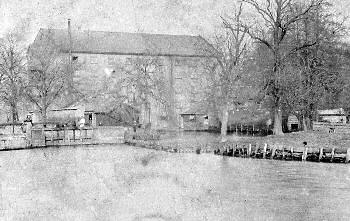 |
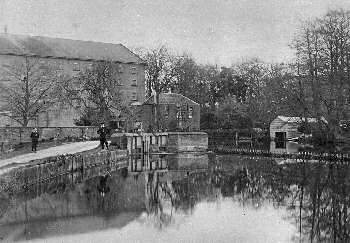 |
|
Mill
dam c.1910
|
Mill
dam c.1920 |
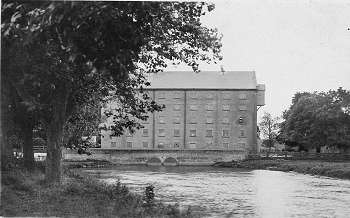 |
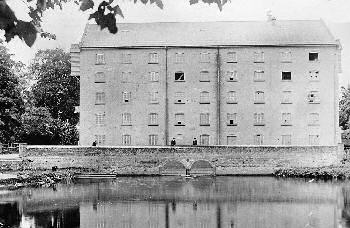 |
Mill and millpond c.1920 |
|
Curiously
the water was turned through 90° at the last minute in order to reach
the wheel, which was set at right angles to the flow of the river. |
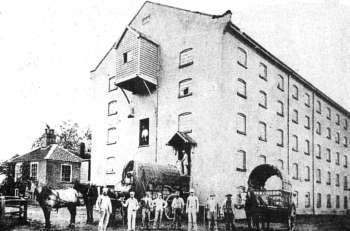 |
|
Mill
workers c.1912
|
Pictured
are John Sisson (1st floor doorway, died in France WWl) Mr. Butterfield (2nd floor doorway) and (standing left to right)
Joe Burgees, Henry Bumphrey (in wagon), John Palmer, Charles Franklin, Walter
Sharpen, Mr. Dyson, Fred Arthurton, boy with broom unknown and Harry Ireson
holding the horse. |
John Sisson in the photo above was born in 1897 and died in service at Ypres on 27th August 1917. Henry Bumphrey was born c.1843 so would have been aged around 69 at the time of the photograph. |
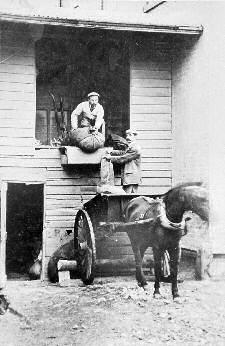 |
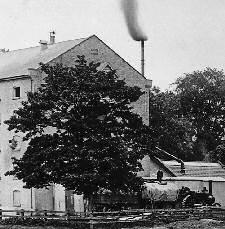 |
|
Loading
flour or cattle feed c.1920
|
Collection
by traction engine c.1920 |
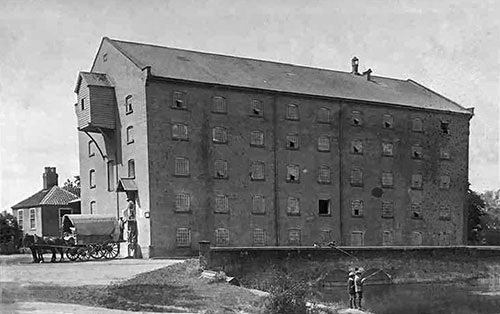 |
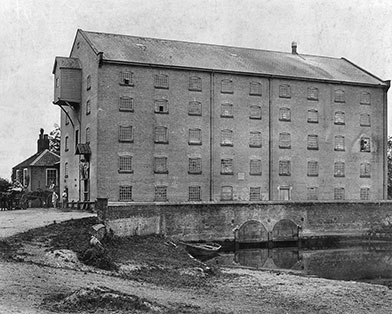 |
|
One of the loaders is Henry Watson Sparkes - 4 boys fishing
c.1914 |
c.1923 |
The
mill was destroyed by fire on 7th July 1924 and the remaining walls were
taken down for safety shortly afterwards. |
Just after 9 am on July 7, 1924, a small oil engine caught fire, and after a fruitless attempt by the staff to extinguish the flames, the Norwich Fire Brigade was called. By
10 am, the flames were at their height and all the floors collapsed, bringing
with them all the noisy machinery.
One of the little touches of bravery was
displayed by PC Porter, who, on hearing a cat crying, entered the bottom
floor and at considerable risk to himself, crawled through the smoke. |
|
Note: PC Porter retrieved the black and white cat, which recovered.
|
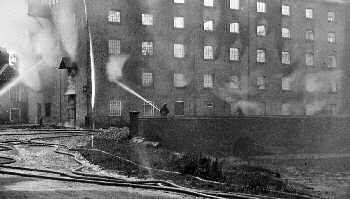 |
|
The mill on fire Monday 7th July 1924
|
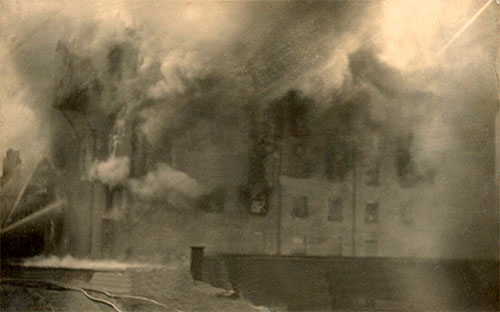 |
The
lucum and mill belching smoke 7th July 1924 |
| I remember seeing the mill
on fire, and all the engines being pumped by hand. We heard the roof and
the ceilings collapsing inside. It was amazing no one was hurt. Frederick Collins, aged 76 - 27th January 1993 Frederick's father, Ernest Collins, kept pigs horses and cattle on land at Long Lane, Bawburgh, which is now part of the Royal Norfolk Showground. Frederick used to visit the mill every week with his father and mother to collect feed for their animals. |
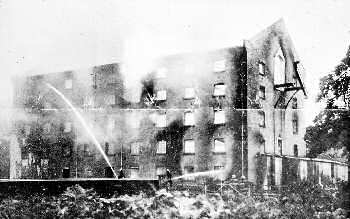 |
|
The
burnt out shell 7th July 1924
|
Damage estimated from £10,000 to £15,000 was occasioned by a fire
which broke out at Costessey Mills abut 9 o'clock yesterday morning, and
which, in an incredibly short space of time, reduced the building, which
was of five storeys, to ruins, leaving only the four outside walls intact.
A south-westerly wind was blowing at the time, and the fire spread at an
alarming rate, for on the arrival of Norwich Fire Brigade, flames were roaring
from all the windows, and only the bottom floor was not alight. By ten o'clock
the flames were at their height, and, fanned by the prevelant breeze, made
it impossible for the time being to cross the bridge spanning the stream
by the mills. The fire engine and trailer were stationed some 120 yards
away from the blaze, and jets were soon playing on the building from all
sides. Eastern Daily Press - 8th July 1924 |
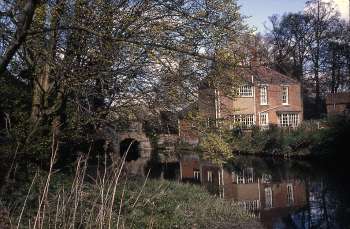 |
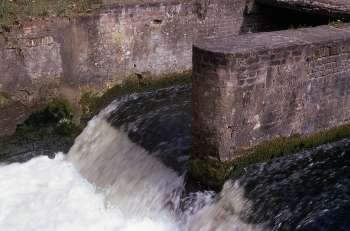 |
|
May 1967
|
May
1969 |
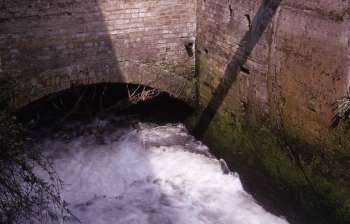 |
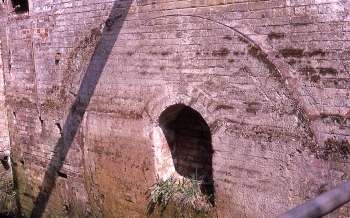 |
|
May 1969 wheelrace and wheel marks
|
May
1969 - note marks made by the old waterwheel |
In
order to maximise flow and minimise flooding, the water authority diverted
the majority of the river around the old mill via a new weir that was completed
in 1989. I noted in January 2004 that relatively little water passes through
the old millrace. |
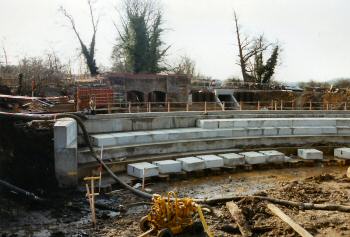 |
|
Construction
of the new weir c.1988
|
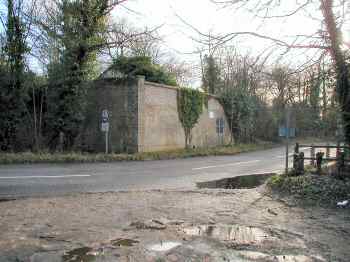 |
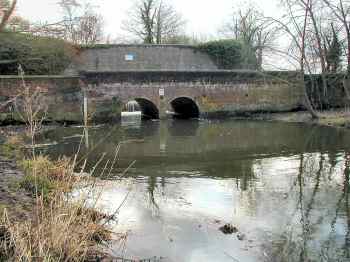 |
|
11th January 2004
|
Old
millrace arches 11th January 2004 |
Henry Bumphrey shown on the 1912 photograph is the great grandfather on my wife. We have established he was born in Wickmere in1843 and married in 1864. The family relocated to Costessey circa 1866. I wonder if he did so to take up employment at the newly rebuilt mill (1859). Mervyn Harrison - 11th June 2009 |
Mills |
|
6.16 The mill structures have a profound influence on the river system in the Wensum catchment. If high retained water levels continue upstream of the mills, they would form a significant constraint on the effectiveness of river restoration. Physical modifications at mill sites should aim to restore a more natural longitudinal profile to the river and to remove or reduce physical barriers to the movement of fish and wildlife. Whilst historically a number of mills have been in existence for centuries these have always very actively stored and released water and the cessation of working of the mills in combination with dredging has had a significant impact. 6.17 The recommended actions at mill structures are shown in Table 9. At a number of sites there is no mill building and removal of water level control structures would be the desired course of action. However, often there are multiple channels at a mill site and it is likely that some hydraulic controls would be needed to maintain a split of flows to all channels. These would probably take the form of a fixed crest and a natural chute that would allow the passage of fish and woody debris. At locations where the water level control structures are part of the historic mill building, there is often a variety of passageways and the best way to lower levels will need to be identified using more detailed survey. Initial action can be taken at low cost by merely adjusting operating levels using the available gates and stop boards. The reduction in head that could be achieved at a typical dry weather flow is also summarised in Table 9. The estimated maximum reduction in backwater length through changing the operational level of the sluices (that is, without the need for major engineering works) is 18km. This would reduce the length of the River Wensum SSSI affected by backwater from mills from 67% to 40%. To achieve this it would be necessary to ensure that no channels downstream of gates or fixed weirs are affected, but this could be a cost effective start to the Wensum restoration. 6.18 It is likely that at some locations, where the channel course has been altered and the mill channel is significantly higher than the natural channel, the main flow could be diverted upstream of the current mill location. Maintaining some flow to the original mill weir is likely to be preferable for aesthetic and heritage reasons, so by-passing is likely to be required in conjunction with lowering of the mill weir. Sites where such a solution is envisaged are at Great Ryburgh and Lyng. 6.19 The control structures at Costessey, Swanton Morley and Fakenham are used for flow gauging by the Environment Agency. Lowering these weirs may mean that the existing gauging arrangements will need to be replaced by other methods, such as ultrasonic techniques. The weir on the main channel at Swanton Morley has a two stage drop and a significant reduction in water level could be achieved there without affecting flow gauging through the bridge. 6.20 A former mill known as Gogg's Mill near to Fakenham was removed as part of the drainage improvement works of the 1950s. The channel upstream of the mill has narrowed significantly through the accretion of silt berms, and provides a good case study of the extent to which natural recovery can help restore natural river form and function. 6.21 As part of the River Wensum Water Level Management Plan being prepared by Entec (2007) the views of some private owners on changes in operating level have been canvassed. In broad terms this is not opposed, but there is concern to maintain an attractive setting incorporating some mill pond in line with the historical context particularly at: 1) Elsing 2) Great Ryburgh 3) Bintree 4) North Elmham 5) Lenwade. 6.22 A reduction in the retained water level at mills may constrain the ability to direct water through all the existing channels at mill sites, should this still be required, there may be a need to carry out physical modifications to some of the subsidiary water level control structures. River Wensum Restoration Strategy - Natural England, 26th June 2009 |
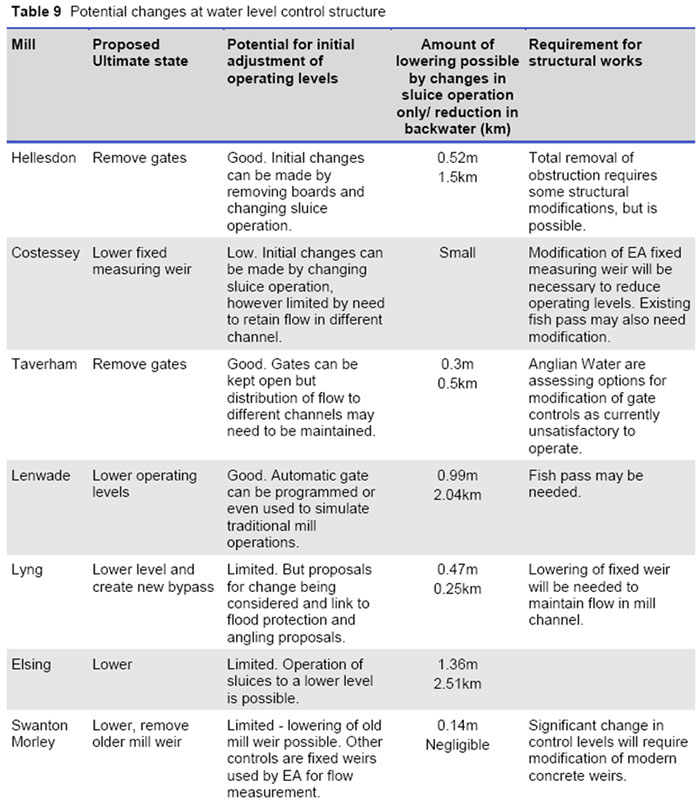
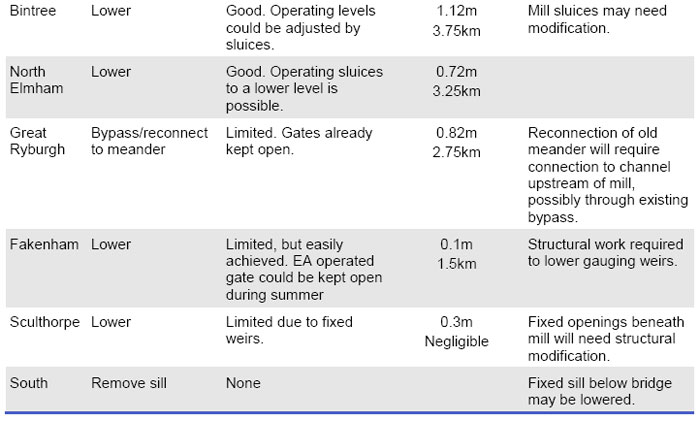
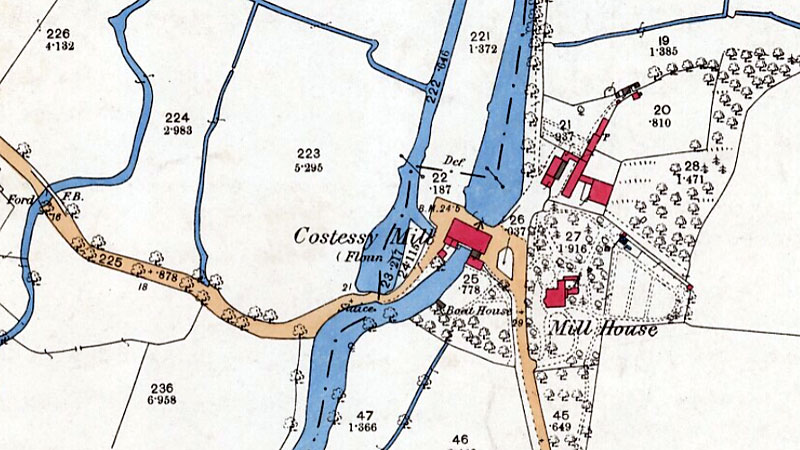 |
O. S. Map 1881 |
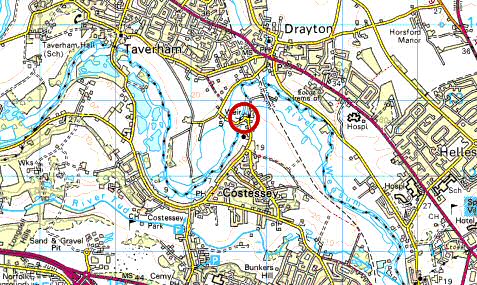 |
|
O.S. Map 2005 Image reproduced under licence from Ordnance Survey |
Domesday survey 1086: Two mills Kelly's 1883: Henry Culley |
If you have any memories, anecdotes or photos please let us know and we may be able to use them to update the site. By all means telephone 07836 675369 or
|
| Nat Grid Ref TG17711274 | Copyright © Jonathan Neville 2004 |